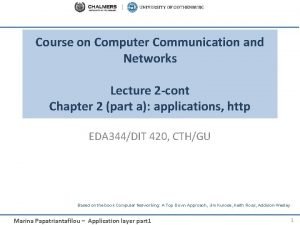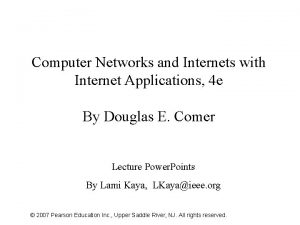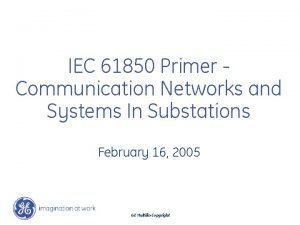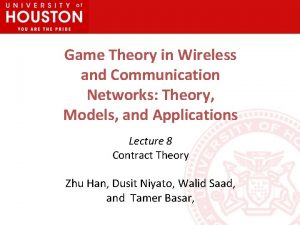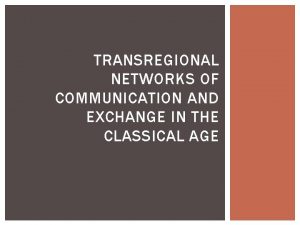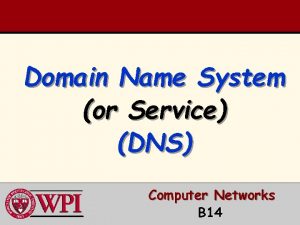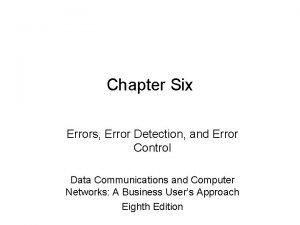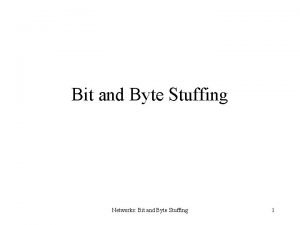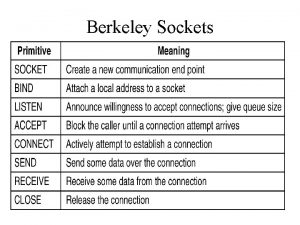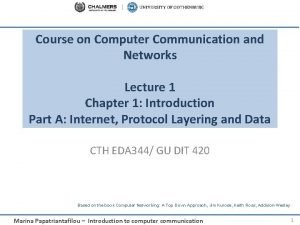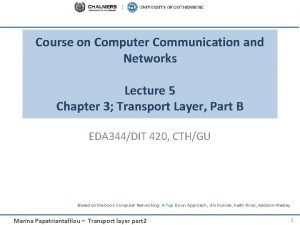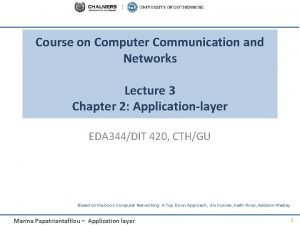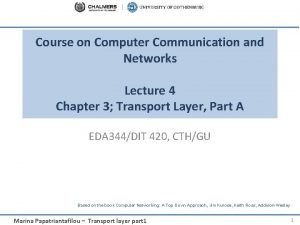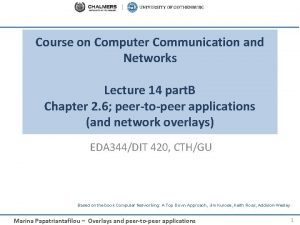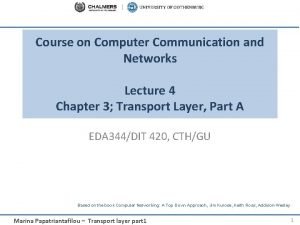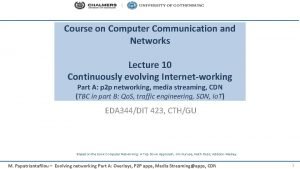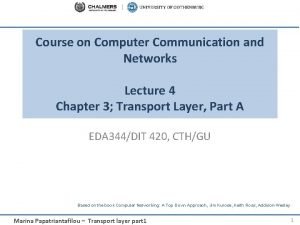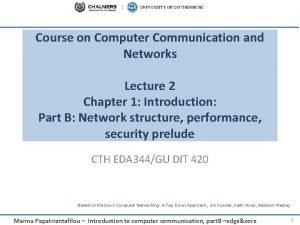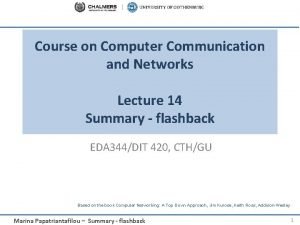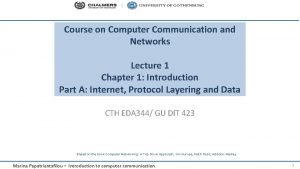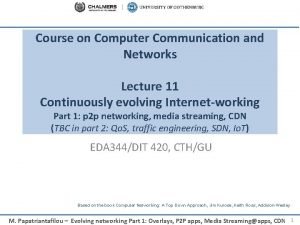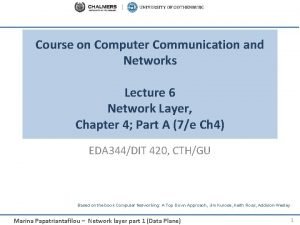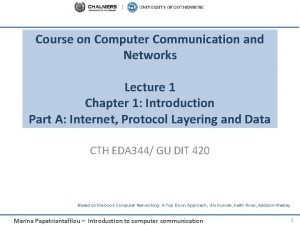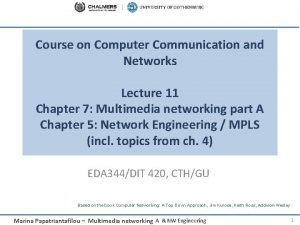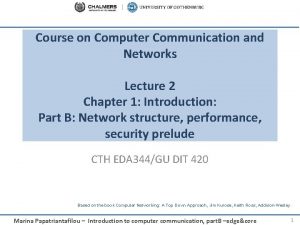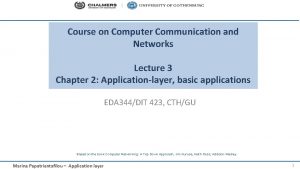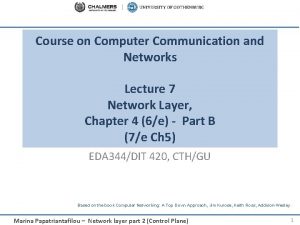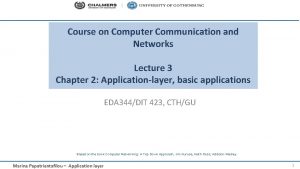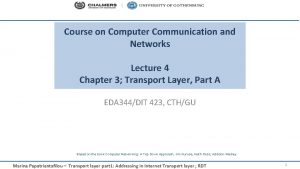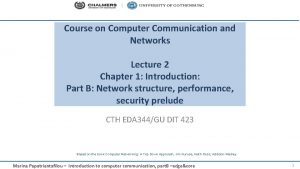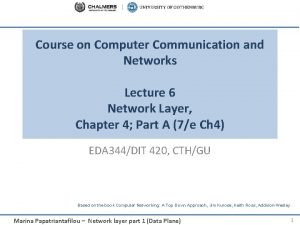Course on Computer Communication and Networks Lecture 16


















































- Slides: 50

Course on Computer Communication and Networks Lecture 16 Synthesis, Summary/flashback and Projection (related topics – continuation of study) EDA 344/DIT 420, CTH/GU Based on the book Computer Networking: A Top Down Approach, Jim Kurose, Keith Ross, Addison-Wesley. Marina Papatriantafilou – Summary – flashback and projection 1

Important for the exam When/where: wednesday March 15, 14. 00 -18. 00, SB-building You may have with you: • English-X dictionary • no calculators, PDAs, etc (if/where numbers matter, do rounding) Grading • 30 -40, 41 -50, 51 -60 (out of 60)= 3, 4, 5 (CTH) • 30 -44, 45 -60 (out of 60) = G, VG (GU) To think during summary-study Have overview, critical eye; explain; ask yourselves: why is this so? / how does it work (or not work)? Marina Papatriantafilou – Summary – flashback and projection 2

Synthesis: a day in the life of a web request • Putting lots-of-what-we-learned together: synthesis! – goal: identify, review protocols (at all layers) involved in seemingly simple scenario: requesting www page – scenario: student attaches laptop to campus network, requests/receives www. google. com Marina Papatriantafilou – Summary – flashback and projection 5 -3

A day in the life …. : scenario DNS server browser Comcast network 68. 80. 0. 0/13 school network 68. 80. 2. 0/24 web page web server 64. 233. 169. 105 Google’s network 64. 233. 160. 0/19 Marina Papatriantafilou – Summary – flashback and projection 5 -4

A day in the life… connecting to the Internet DHCP UDP IP Eth Phy DHCP connecting laptop needs to get its own IP address: use DHCP request encapsulated in DHCP DHCP UDP IP Eth Phy UDP, encapsulated in IP, encapsulated in Ethernet router (runs DHCP) r Ethernet frame broadcast (dest: FFFFFF) on LAN, received at router running DHCP server r Ethernet demux’ed to IP demux’ed to UDP demux’ed to DHCP Marina Papatriantafilou – Summary – flashback and projection 5 -5

A day in the life… connecting to the Internet DHCP UDP IP Eth Phy DHCP DHCP server formulates DHCP ACK containing client’s IP address (and also IP address of first-hop router for client, name & IP address of DNS server) r frame forwarded (switch DHCP DHCP UDP IP Eth Phy learning) through LAN, demultiplexing at client router (runs DHCP) r DHCP client receives DHCP ACK reply Client now has IP address, knows name & addr of DNS server, IP address of its first-hop router Marina Papatriantafilou – Summary – flashback and projection 5 -6

A day in the life… ARP (before DNS, before HTTP) DNS DNS ARP query before sending HTTP request, need IP address of www. google. com: DNS UDP IP ARP Eth Phy r DNS query created, encapsulated in ARP reply Eth Phy UDP, encapsulated in IP, encasulated in Eth. In order to send frame to router, need MAC address of router interface: ARP r ARP query broadcast, received by router, which replies with ARP reply giving MAC address of router interface r client now knows MAC address of first hop router, so can now send frame containing DNS query Marina Papatriantafilou – Summary – flashback and projection 5 -7

A day in the life… using DNS DNS UDP IP Eth Phy DNS DNS DNS UDP IP Eth Phy DNS server Comcast network 68. 80. 0. 0/13 r IP datagram forwarded from campus r IP datagram containing DNS query forwarded via LAN switch from client to 1 st hop router network to destination (DNS-server) network, routed (tables created by RIP, OSPF and BGP routing protocols) to DNS server r demux’ed to DNS server replies to client with IP address of www. google. com Marina Papatriantafilou – Summary – flashback and projection 8

A day in the life… TCP connection carrying HTTP TCP IP Eth Phy SYNACK SYN r to send HTTP request, client SYNACK SYN TCP IP Eth Phy web server 64. 233. 169. 105 first opens TCP socket to web server r TCP SYN segment (step 1 in 3 way handshake) inter-domain routed to web server responds with TCP SYNACK r TCP connection established! Marina Papatriantafilou – Summary – flashback and projection 5 -9

A day in the life… HTTP request/reply HTTP TCP IP Eth Phy HTTP HTTP r web page finally (!!!) displayed r HTTP request sent into TCP socket HTTP HTTP TCP IP Eth Phy web server 64. 233. 169. 105 r IP datagram containing HTTP request routed to www. google. com r web server responds with HTTP reply (containing web page) r IP datgram containing HTTP reply routed back to client Marina Papatriantafilou – Summary – flashback and projection 5 -10

Principles, Organisation Network Problems • • • Mobility, performance, security, …, … serving different types of traffic, connecting transparently different networks, routing, congestion control, access to shared (broadcast) transmission medium producer-consumer problems, flow and error control Layering : principle, why Marina Papatriantafilou – Summary – flashback and projection 11

Highlights network security issues Softwaredefined networks TCP/IP, LAN protocol stack multiple access protocols (wired, wireless) delays performance routing, also with mobility reliable data transfer Marina Papatriantafilou – Summary – flashback and projection datagram vs VC congestion control 12

Types of delay; performance • Propagation, transmission, queueing, processing • Throughput (effective bandwidth), Utilization -efficiency • Packet-switching: impact of store&forward, pipelines, space-time diagrams • Sliding windows performance • Relation between delays-losses transmission A propagation B nodal processing queuing Marina Papatriantafilou – Summary – flashback and projection 13

Reliable data transfer Guaranteed, in-order, correct delivery: – – – – stop&wait sliding windows sequence numbers window sizes dynamic windows (TCP) performance flow control • Error detection: checksums • Error control: go-back-n, selective repeat, FEC methods Marina Papatriantafilou – Summary – flashback and projection 14

Datagram vs VC endto-end comm. Congestion Control RT traffic/streaming Marina Papatriantafilou – Summary – flashback and projection 15

Datagram vs VC end-to-end communication • Conceptual differences • Decisions, comparison Marina Papatriantafilou – Summary – flashback and projection 16

Congestion control (CC) • why, how congestion occurs • CC in TCP and performance; implied weaknesses • CC in other ways, e. g. VC-based networks – Real-time (RT)-traffic resource reservation: traffic shaping and policing – rate-based Marina Papatriantafilou – Summary – flashback and projection 17

RT/streaming traffic Internet context • Application-level solutions (playout delay, forward-errorcontrol, caching-CDN) • Intserv, Diffserv, traffic engineering, SDN Conceptual needs: • packet/flow marking • Admission control • Traffic shaping & policing • Packet scheduling Marina Papatriantafilou – Summary – flashback and projection 18

Highlights network security issues Softwaredefined networks TCP/IP, LAN protocol stack multiple access protocols (wired, wireless) delays performance routing, also with mobility reliable data transfer Marina Papatriantafilou – Summary – flashback and projection datagram vs VC congestion control 19

Routing, also with mobility • • • Routing algorithms, protocols Forwarding in routers Resource, policy issues Data plane and control plane in SDN Addressing mobility, tunneling 5 2 A 3 B 2 1 D C 3 1 Mobile Switching Center Marina Papatriantafilou – Summary – flashback and projection 5 F 1 E 2 Public telephone network, and Internet 20

Medium access: multiple access methods Strategies: (functionality, appropriateness) • Contention-based (random access), wired/wireless: – Aloha, CSMA(CD/CA) • Collision-free: – Channel partitioning: TDMA, FDMA, CDMA – Taking turns: e. g. tokens, reservation-based B A C C’s signal strength A’s signal strength space Marina Papatriantafilou – Summary – flashback and projection 21

Highlights network security issues Softwaredefined networks TCP/IP, LAN protocol stack multiple access protocols (wired, wireless) delays performance routing, also with mobility reliable data transfer Marina Papatriantafilou – Summary – flashback and projection datagram vs VC congestion control 22

TCP/IP protocol stack, applications, evolution • Instantiation of network- solutions (Routing, Congestion Control, Flow & error control, applications, link layer technologies) • Advantages, limitations, updates • New types of applications and how they function given the existing state of Internet Marina Papatriantafilou – Summary – flashback and projection 23

LANs & related link technologies • Protocol Examples: wired, wireless Ethernet, 802. xy, GSM: Functionality, performance under low/high load • Connecting devices; – functionalities and differences (Hubs, switches) – Algorithms for switch-”routing”: learning& forwarding of packets • ARP switch Marina Papatriantafilou – Summary – flashback and projection 24

Highlights network security issues Softwaredefined networks TCP/IP, LAN protocol stack multiple access protocols (wired, wireless) delays performance routing, also with mobility reliable data transfer Marina Papatriantafilou – Summary – flashback and projection datagram vs VC congestion control 25

Security issues • C, I, A and methods to achieve them – The language of cryptography – Message integrity, signatures • Instantiation in Internet: SSL, IPsec • Firewalls Alice Bob channel data, control messages secure sender secure s receiver data Trudy Marina Papatriantafilou – Summary – flashback and projection 26

Overlays, CDN, SDN • P 2 P/streaming applications-infrastructure (application-layer networking) • traffic engineering, tunneling • Software-defined networks: separation of control and execution planes; virtualization of ”network layer functionality”: eg. routing table updates implemented elsewhere (not in particular routers) • (related to data centers, 5 G; Internet of Things) … complement the networking infrastructure … Marina Papatriantafilou – Summary – flashback and projection 27

Main questions asked by you: 1. How can we have reliable data transfer on top of UDP – Implementation at app-layer 2. Difference between addressing in transport layer and in network layer? (e. g. TCP headers add source and destination IP addresses but these addresses are also added in the network layer: Is it redundant ? ) – Some redundancy yes, TCP uses it for demux 3. ”special” IP address(mask) 192. 168. 0. 0/16 – Local, behind NAT; was standard global address in earlier, classful IPaddressing; preserved for historical & engineering reasons 4. Working with time-space diagrams – See next slide 5. Discuss exercise on slide 12 of 12. lecture. NWcore. And. Media. SDN – Discussed in class Marina Papatriantafilou – Summary – flashback and projection 28

4: eg What is a full-utilization window? sender receiver first packet bit transmitted, t = 0 last bit transmitted, t = L / R RTT first packet bit arrives last packet bit arrives, send ACK last bit of 2 nd packet arrives, send ACK last bit of 3 rd packet arrives, send ACK arrives, send next packet, t = RTT + L / R E. g. for 100% utilization, calculate how many packets can fill in RTT + L / R, ie (RTT + L / R)/ (L / R) Marina Papatriantafilou – Summary – flashback and projection 3 b-29

5: Policing: the effect of buckets • input • output pure leaky bucket, 2 MBps • output token bucket 250 KB, 2 MBps • output token bucket 500 KB, 2 MBps • output token bucket 750 KB, 2 MBps • output token bucket 500 KB, 2 MBps, feeding 10 MBps leaky bucket Multimedia+ATM; Qo. S, Marina Papatriantafilou – Summary – flashback and projection 30

Synthesis cont. 1. Reflections, prespectives 2. Networking constantly evolving Marina Papatriantafilou – Summary – flashback and projection 5 -31

The Internet: virtualizing networks 1974: multiple unconnected nets – – ARPAnet data-over-cable networks packet satellite network (Aloha) packet radio network ARPAnet … differing in: m addressing conventions m packet formats m error recovery m routing satellite net "A Protocol for Packet Network Intercommunication", V. Cerf, R. Kahn, IEEE Transactions on Communications, May, 1974, pp. 637 -648. Marina Papatriantafilou – Summary – flashback and projection 5 -32

The Internet: virtualizing networks Internetwork layer (IP): r addressing: internetwork appears as single, uniform entity, despite underlying local network heterogeneity r network of networks Gateway: • “embed internetwork packets in local packet format” • route (at internetwork level) to next gateway ARPAnet satellite net Marina Papatriantafilou – Summary – flashback and projection 5 -33

Internet structure: network of networks Question: given millions of access ISPs, how to connect them together? access net … access net … … access net access net … Marina Papatriantafilou – Summary – flashback and projection … access net

Internet structure: network of networks Option: connect each access ISP to every other access ISP? access net … access net … … connecting each access ISP to each other directly doesn’t scale: O(N 2) connections. … … access net access net … Marina Papatriantafilou – Summary – flashback and projection … … access net

Internet structure: network of networks Option: connect each access ISP to a global transit (imaginary) ISP? Customer and provider ISPs have economic agreement. access net … access net … … access net global ISP access net access net … Marina Papatriantafilou – Summary – flashback and projection … access net

Internet structure: network of networks But if one global ISP is viable business, there will be competitors …. access net … access net access net … … ISP A access net ISP B ISP C access net … Marina Papatriantafilou – Summary – flashback and projection … access net

Internet structure: network of networks But if one global ISP is viable business, there will be competitors …. which must be interconnected Internet exchange point access net … net access net … (ca 300 in the world; multiple ISPs peering/switching; access 3 rd company) net access net … … ISP A IXP access net ISP B ISP C access net peering link access net (no payment to each-other) access net … Marina Papatriantafilou – Summary – flashback and projection … access net

Internet structure: network of networks … and regional networks may arise to connect access nets to ISPS access net … … access net access net … … ISP A IXP access net ISP B ISP C access net regional net access net … Marina Papatriantafilou – Summary – flashback and projection … access net

Internet structure: network of networks … and content provider networks (e. g. , Google, Microsoft, Akamai ) may run their own network, to bring services, content close to end users access net … … access net access net Content provider network IXP access net ISP B access net regional net access net … Marina Papatriantafilou – Summary – flashback and projection … access net … … ISP A access net

Internet structure: network of networks Tier 1 ISP IXP Regional ISP access ISP • access ISP Google access ISP IXP Regional ISP access ISP at center: small # of well-connected large networks – “tier-1” commercial ISPs (e. g. , AT&T, NTT, Telia. Sonera, Deutche. Telecom), national & international coverage – A new form of content provider network (e. g, Google): private network that connects it data centers to Internet, often bypassing. Introduction tier-1, regional ISPs Marina Papatriantafilou – Summary – flashback and projection 1 -41

Synthesis cont. 1. Reflections, prespectives 2. Networking constantly evolving Marina Papatriantafilou – Summary – flashback and projection 5 -42

Data center networks • 10’s to 100’s of thousands of hosts, often closely coupled, in close proximity: – e-business (e. g. Amazon) – content-servers (e. g. , You. Tube, Akamai, Apple, Microsoft) – search engines, data mining (e. g. , Google) v challenges: § multiple applications, each serving massive numbers of clients § managing/balancing load, networking, data bottlenecks Inside a 40 -ft Microsoft container, Chicago data center Marina Papatriantafilou – Summary – flashback and projection 5 -43

Data center networks(SDNrelevance) load balancer: application-layer routing § receives external client requests § directs workload within data center § returns results to external client (hiding data center internals from client) Internet § Distributed systems & networks working together Border router Load balancer Access router Tier-1 switches B A Load balancer C Tier-2 switches TOR switches Server racks 1 2 3 4 5 6 7 8 Marina Papatriantafilou – Summary – flashback and projection 5 -44

Data center networks (SDNrelevance) v rich interconnection among switches, racks: § increased throughput between racks (multiple routing paths possible) § increased reliability via redundancy § Distributed systems & networks working together Tier-1 switches Tier-2 switches TOR switches Server racks 1 2 3 4 5 6 7 8 Marina Papatriantafilou – Summary – flashback and projection

guest lecture (joint with Adv. Distributed Systems course) will be rescheduled outside the Study Period Niklas Gustavsson, engineering team leader at Spotify, Gothenburg Marina Papatriantafilou – Summary – flashback and projection 5 -46

More examples: a story in progress + possible followup course. . . Overlays useful here, too: Marina Papatriantafilou – Summary – flashback and projection

New power grids: be adaptive! • Bidirectional power and information flow – Micro-producers or “prosumers”, can share resources – Distributed energy resources • Communication + resourceadministration (distributed system) layer: Io. T Marina Papatriantafilou – Summary – flashback and projection 48

El-networks as distributed cyber-physical systems Overlay network El- link and/or communication link Computing+ communicating device Cyber system Physical system Course (DAT 300, LP 1): ICT Support Cyberphysical Systems Connecting Distributed Systems, Networks, Data processing and Security in CPS Marina Papatriantafilou – Summary – flashback and projection

Thank you Recall, important for the exam: When/where: wednesday March 15, 14. 00 -18. 00, SB You may have with you: • English-X dictionary • no calculators, PDAs, etc (if/where numbers matter, do rounding) To think during last, summary-study Overview; critical eye; explain; ask yourselves: why is this so? / How does it work? Good luck with all your efforts!!! “If you hear a voice within you say ‘you cannot paint, ’ then by all means paint, and that voice will be silenced. ” – Vincent Van Gogh Marina Papatriantafilou – Summary – flashback and projection 50
 Difference between datagram and virtual circuit network
Difference between datagram and virtual circuit network Basestore iptv
Basestore iptv 01:640:244 lecture notes - lecture 15: plat, idah, farad
01:640:244 lecture notes - lecture 15: plat, idah, farad Computer communication course
Computer communication course Course number and title
Course number and title Integrated and differentiated services in computer networks
Integrated and differentiated services in computer networks Error detection in computer networks
Error detection in computer networks Byte stuffing example
Byte stuffing example Difference between bit stuffing and byte stuffing
Difference between bit stuffing and byte stuffing Arp vs rarp
Arp vs rarp Analog and digital signals in computer networking
Analog and digital signals in computer networking Http computer networks
Http computer networks Computer networks and internets with internet applications
Computer networks and internets with internet applications Error correction in computer networks
Error correction in computer networks Protocols and standards in computer networks
Protocols and standards in computer networks Crc in computer networks
Crc in computer networks Computer networks and internets
Computer networks and internets Iec 61850 communication networks and systems in substations
Iec 61850 communication networks and systems in substations Game theory in wireless and communication networks
Game theory in wireless and communication networks Networks of communication and exchange
Networks of communication and exchange Cut brick lengthwise
Cut brick lengthwise Course interne course externe
Course interne course externe Computer security 161 cryptocurrency lecture
Computer security 161 cryptocurrency lecture Computer aided drug design lecture notes
Computer aided drug design lecture notes Computer architecture lecture notes
Computer architecture lecture notes Computer architecture lecture
Computer architecture lecture Crisis communications lecture
Crisis communications lecture Business communication lecture slides
Business communication lecture slides Crc in computer networks
Crc in computer networks Crc in computer networks
Crc in computer networks Traffic management in computer networks
Traffic management in computer networks Tpdu in computer networks
Tpdu in computer networks What is optimality principle in computer networks
What is optimality principle in computer networks In band management definition
In band management definition What is optimality principle in computer networks
What is optimality principle in computer networks Applications of computer networks
Applications of computer networks Definition of computer
Definition of computer Dns in computer networks
Dns in computer networks Icmp in computer networks
Icmp in computer networks Character stuffing in computer networks
Character stuffing in computer networks Dns in computer networks
Dns in computer networks Computer networks assignment
Computer networks assignment Distributed system in computer network
Distributed system in computer network Badrinath
Badrinath Internet transport protocol in computer networks
Internet transport protocol in computer networks Error control in computer networks
Error control in computer networks Subnet
Subnet Data link layer switching
Data link layer switching Layered task
Layered task Hdlc bit stuffing
Hdlc bit stuffing Socket primitives of tcp
Socket primitives of tcp



